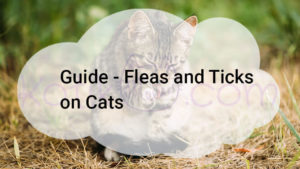- → 9 Methods of Natural Flea Control for Cats
- 1. Give Your Cat A Bath
- 2. Flea-Comb Your Cat Every Day
- 3. Set A Non-Toxic Trap
- 4. Launder Your Cat’s Bedding Regularly
- 5. Vacuum, Vacuum, Vacuum
- 6. Try Diatomaceous Earth, Which Dehydrates Fleas
- 7. Clean Your Yard And Give It Some Worms
- 8. Do Not Give Your Cat Garlic!
- 9. Also, Be Careful Of Essential Oils
Concerned about using toxic chemicals to treat and prevent fleas on your kitty? We’ve compiled nine natural methods of flea control for cats that you can easily try yourself at home.
→ 9 Methods of Natural Flea Control for Cats
Monthly topical treatments have been a godsend for those of us who remember trying to battle flea infestations with sprays, collars, powders and even nasty, toxic “flea dips”. But if you have a chronic health problem, chemical sensitivity, young children in your home or kittens with fleas — or even if you just want to go easier on your cat and on the Earth — you might want to use less toxic alternatives to keep the pests at bay. Here are some safer ways for natural flea control for cats, your home and your yard.
1. Give Your Cat A Bath

Yes, I know that sounds ridiculous, but if your cat has a lot of fleas, bathing your cat with a non-irritating product such as unscented castile soap diluted fifty fifty with water will be very helpful. Before you bathe your cat, lather up some soap around his neck and ears to keep the fleas from fleeing to the dry ground of his head. Follow the bath with a thorough combing using a fine-toothed flea comb.
2. Flea-Comb Your Cat Every Day
Make sure you pay extra attention to the neck, stomach and the base of the tail, because that’s where fleas are most likely to live on your cat. Dip your flea-filled comb into a jar of water with a film of dish detergent on the top. This will drown the fleas.
3. Set A Non-Toxic Trap
Put a dish of soapy water under a night-light near where your cat sleeps. Fleas will be attracted to the warmth of the light and drown in the soapy water. If you’d rather not put water dishes near where your cat sleeps, electric flea traps are another option.
4. Launder Your Cat’s Bedding Regularly
By washing your cat’s bedding and blankets you use on your furniture in hot water and drying them on high heat, you’ll kill flea eggs and larvae. Wash any cloth throw rugs, too.
5. Vacuum, Vacuum, Vacuum
Vacuum your entire home, including the furniture, at least once a week. Some experts recommend putting a mothball in your vacuum bag to kill the fleas. When you’re done, take the bag right outside. If you have a bagless vacuum, empty the dust receptacle outdoors and wash it thoroughly with soap and water before bringing it back inside.
6. Try Diatomaceous Earth, Which Dehydrates Fleas
Sprinkle food-grade diatomaceous earth (DE) on your carpets and floors, leave it down for as long as possible, and then vacuum it (and the dead fleas) up. Do not use diatomaceous earth designed for use in pools, because pool-grade DE has been treated with toxic chemicals. If you have breathing issues, you may want to use a mask when you sprinkle the DE around, because it is a light powder that could trigger respiratory problems.
7. Clean Your Yard And Give It Some Worms
Keep your lawn mowed short, remove debris such as brush piles, and sprinkle lots of beneficial nematodes — special roundworms that love to eat flea larvae — around your yard.
8. Do Not Give Your Cat Garlic!
A lot of natural living sites recommend that you give your pet garlic as a flea control tool, but garlic is highly toxic to cats and can cause life-threatening anemia.
9. Also, Be Careful Of Essential Oils
Another widely touted option for flea control is the use of essential oils, either in your cat’s food or on her fur. But many essential oils contain substances that are toxic to cats. Do not use any essential oils on your cat unless you’ve been advised to do so by a cat-savvy essential oil practitioner.
For more information about aromatherapy for cats, check out this post by Celeste Yarnall, author of The Complete Guide to Holistic Cat Care.







